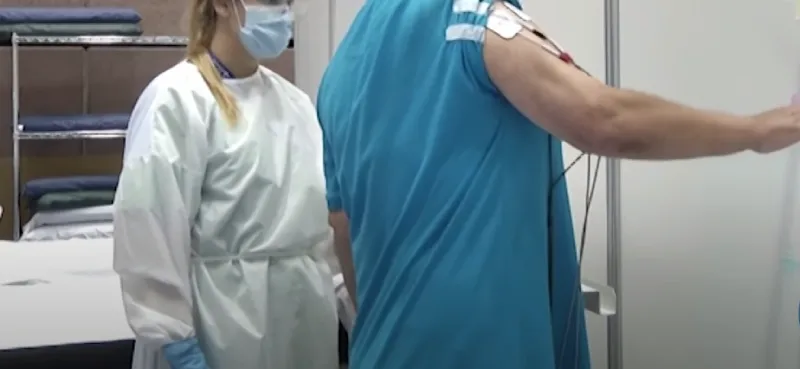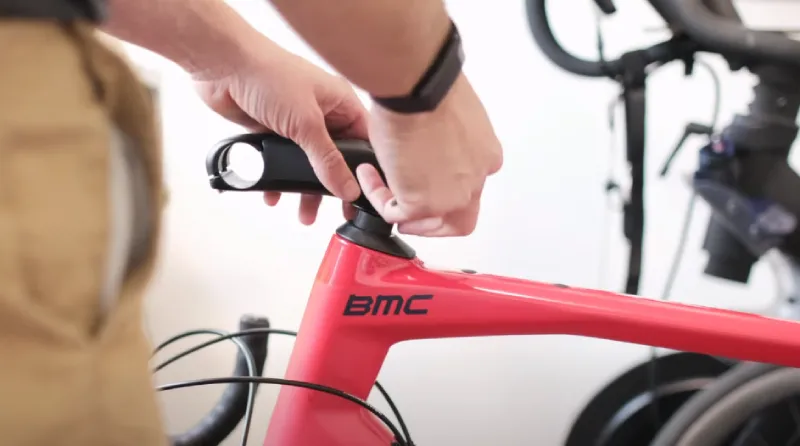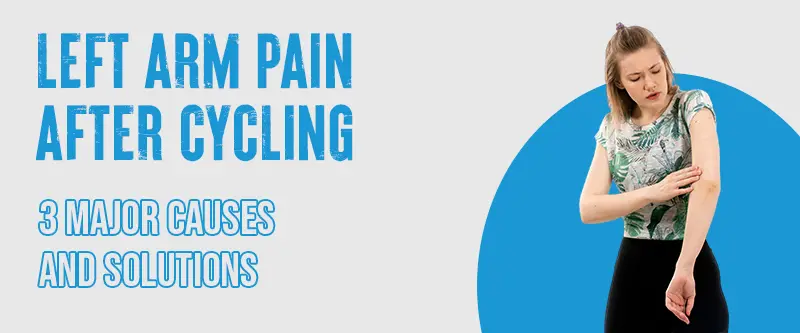An enlarged heart or reduced blood flow to the heart muscle may cause arm pain during activity that improves with rest. When the arm suddenly snaps or cracks, the cause may be heart problems, injuries, herniated discs, pinched nerves, and vascular thoracic outlet syndrome.
Excessive downward or upward tilts compress the wrists after cycling. Forearms and elbows can be painful in extreme cases. You can achieve a very slight up and inward angle by moving the hoods under the bar tape or adjusting the rotation of the handlebars.
In this blog post, we’ll explore the causes and symptoms of left arm pain after cycling and tips and solutions for prevention and treatment.
Left Arm Pain After Cycling: 7 Ways to Stop It Now

After a long ride, one is expected to experience pain or discomfort in the arms and hands. This can be attributed to several factors. We will explore reasons for cycling left arm pain and provide solutions for prevention and recovery.
Muscle Fatigue
Cycling enthusiasts often experience discomfort and pain in their left arm after a vigorous ride. Understanding the science behind muscle fatigue is crucial for finding practical solutions. During cycling, let’s delve into the common symptoms, causes, and remedies for muscle fatigue in the forearms and arms.
Common Symptoms and Causes
- Tightness and Soreness: Persistent tightness and soreness in the forearm muscles after cycling.
- Reduced Endurance: Difficulty sustaining grip and endurance during longer rides.
- Limited Range of Motion: Feeling constrained in the arm’s range of motion.
Solutions
- Changing Hand Positions: Rotate hand positions regularly to distribute the load evenly.
- Relaxing the Grip: Maintain a relaxed grip on the handlebars to alleviate tension.
- Stretching: Incorporate pre- and post-ride stretches to enhance flexibility.
- Massage: Massage your muscles to promote recovery and reduce fatigue. This practice can also relieve arm biceps pain.
Nerve Compression
Left arm pain after cycling may also be attributed to nerve compression issues like Ulnar Neuropathy and Carpal Tunnel Syndrome. We will explore the symptoms, causes, and preventive measures for nerve compression during cycling.
Common Symptoms and Causes
- Numbness and Tingling: Experience numbness, tingling, or a burning sensation in the hands.
- Pain in Hands and Upper Arms: Sharp or throbbing pain in the hands and upper arms during or after cycling.
- Wrist pain: Feel discomfort due to wrist extension or flexion after biking.
Solutions
- Adjusting Riding Position: Ensure proper bike setup to reduce pressure on hands nerves.
- Shock-Absorbing Handlebar Tape or Gel: Use tape or gel to absorb shocks and vibrations.
- Padded Gloves: Invest in gloves with padding to cushion the hands and wrists.
- Avoiding Wrist Movements: Minimize unnecessary wrist movements during rides.
Bike Fit

The link between poor bike fit and left arm pain during cycling is undeniable. Cycling posture or incorrect bike fit can cause excessive strain on specific muscles, resulting in arm cramps. A poorly fitted bike cannot only affect the left hand but also cause right arm pain. Let’s explore the symptoms, causes, and practical solutions for achieving an optimal bike fit to enhance your riding experience.
Common Symptoms and Causes
- Improper Posture: Experience discomfort due to incorrect riding posture.
- Alignment Issues: Misalignment leads to strain on the left arm and shoulder pain after cycling.
- Biomechanical Challenges: Difficulty in maintaining a biomechanically efficient riding position.
Solutions
- Professional Fitting: Seek expert guidance for a personalized bike fitting session.
- Choosing the Right Frame Size: Ensure your bike frame is the right size for your arms.
- Handlebar Width: Optimal handlebar width to promote comfort and reduce strain.
- Ergonomic Accessories: Explore ergonomic accessories to enhance your bike’s comfort level.
Left Arm Throbbing While Cycling
An arm throbbing pain while cycling, particularly in women, could indicate a few specific issues, including muscle strain, overuse injury, or underlying medical conditions. It is essential to pay attention to such symptoms and consider seeking medical advice.
Heart-Related Concerns
Discomfort or pain in the left arm can cause cardiovascular problems, especially in women. It could signal angina (chest pain) or a heart attack.
If you experience this pain along with other symptoms such as chest pain, breathlessness, nausea, or dizziness, seeking prompt medical help is vital.
Thoracic Outlet Syndrome
This condition arises when the nerves and blood vessels between the collarbone and first rib (known as the thoracic outlet) experience compression.
Poor cycling posture can worsen this condition, resulting in discomfort, numbness, or tingling sensations in the arm and hand.
CTS in Woman
While wrist pain and tingling are common symptoms of carpal tunnel syndrome, they can also radiate pain in the forearm and top of the left arm. Tight gripping of handlebars while cycling may worsen this condition.
Muscle Strain
Cycling entails repetitive movements. If your bike is not properly fitted to your body or your posture is incorrect, it can strain arm muscles, resulting in persistent pain in the left arm and shoulder female.
Left arm pain in women can signal serious medical issues, so don’t ignore it. If you have persistent or severe pain, especially with other symptoms, consult a healthcare professional promptly for evaluation and treatment.
Overexertion
Intense or prolonged cycling can strain the abdominal muscles, leading to abdominal pain, fatigue, soreness, and cramping after cycling. To avoid overexertion, accumulate the intensity and duration of your rides.
Conclusion
Left arm pain after cycling is a common issue that many cyclists face. We explored the three leading causes of arm pain: muscle fatigue, nerve compression, and poor bike fit.
We also outlined solutions to prevent and treat these issues, such as changing hand positions, adjusting your riding position, or investing in ergonomic accessories. Cycling can be a great way to stay active and healthy, but it’s essential to approach it with caution and care.
You’ll avoid any undesirable pain or discomfort by listening to your body, warming up and cooling down, hydrating, and resting. We encourage you to share your experiences and feedback with fellow cyclists to enhance everyone’s enjoyment of cycling.
FAQs
What Is The Recovery Time of Cyclist’s Palsy?
Surgery is rarely necessary in severe cases, and recovery can last up to six weeks. Although temporary, specific symptoms may endure for up to eight weeks or even beyond. If your symptoms persist or worsen, it is advisable to seek assistance from a medical professional.
Why Do My Arms Hurt After Cycling?
Insufficient saddle layback shifts your center of gravity forward on the bike, leading to added pressure on your arms and hands. This issue often arises when riders try to compensate for a too long bike, causing discomfort in the elbows and hands.


